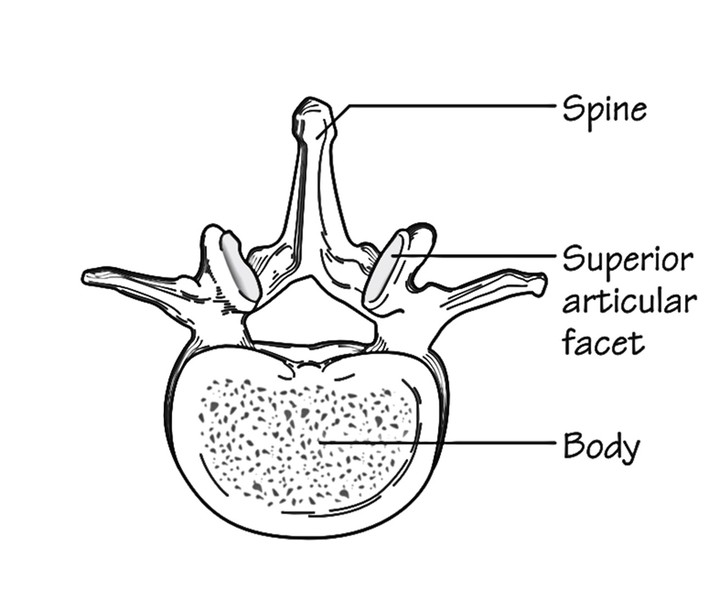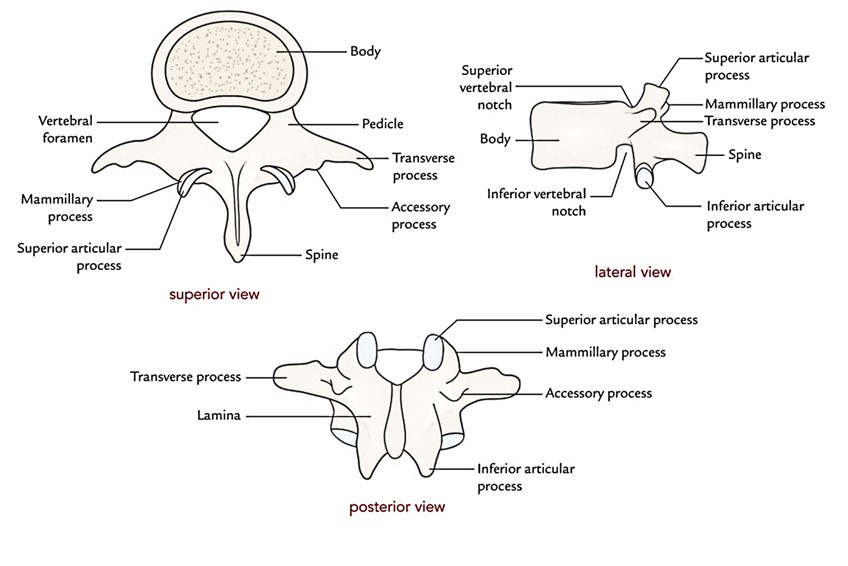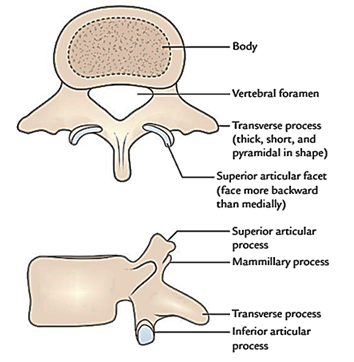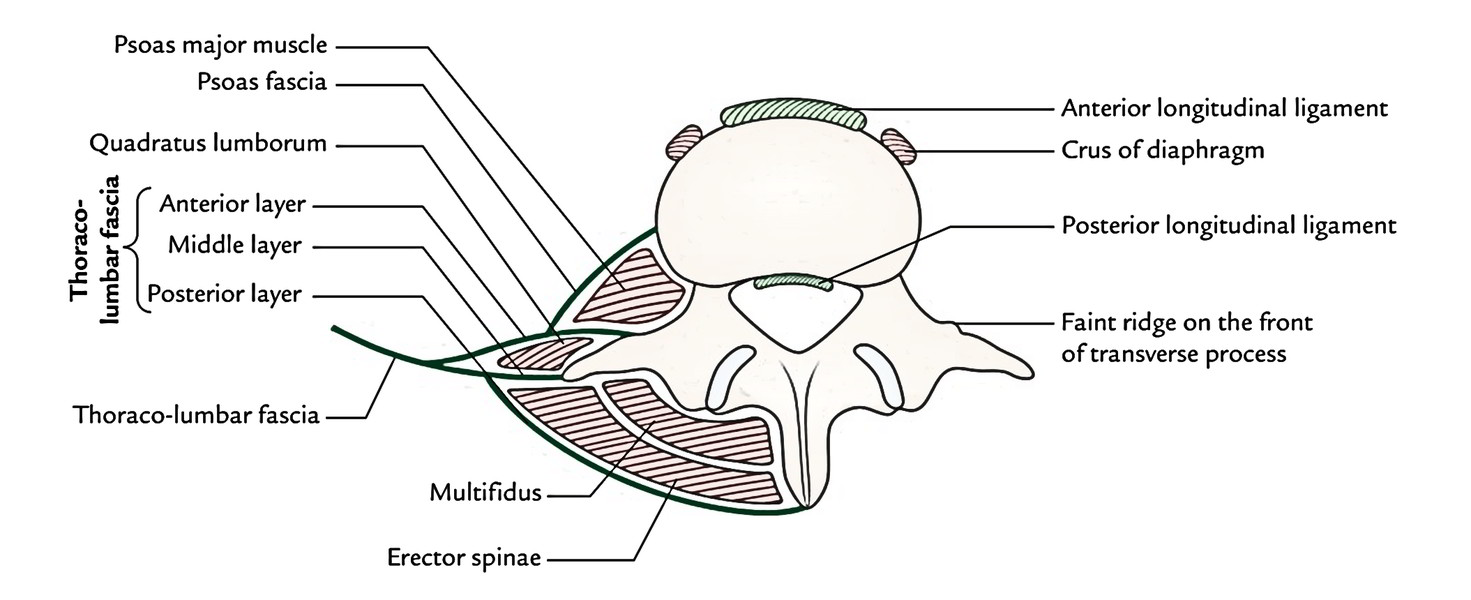Lumbar Vertebrae are the five individual cylindrical bones that form the shape of the spine in the lower back.The components contained by the lumbar vertebrae are same as the thoracic vertebrae but to carry the greater load, these components are gigantic. There are 5 lumbar vertebrae out of which first 4 (L1 to L4) are typical and fifth (L5) is atypical.
Identifying features of the lumbar vertebrae are as follows:
- Enormous reniform bodies.
- Absence of costal facets on the body.
- Absence of foramina transversaria in the transverse processes.
- Presence of accessory and mammillary processes.
- Thick quadrilateral spinous processes.
Features of Typical Lumbar Vertebrae (L1, L2, L3, L4)
General Features
Body
- The body is enormous and reniform.
- Its transverse diameter is more in relation to the anteroposterior diameter.
- It’s constricted in front and at the sides.
- The size of the body increases progressively from first to fifth lumbar vertebra.
- The length of the body is somewhat greater anteriorly. This leads to the forward convexity of the lumbar vertebral column.
- The body has no costal facets on its sides.
Vertebral Foramen
- It’s triangular in shape.
- It’s bigger than in the thoracic vertebrae but smaller than in the cervical vertebrae.
Vertebral Arch Pedicles
- The pedicles are brief and powerful processes.
- They project backwards from the upper parts of the body; as an outcome, the inferior vertebral notches are considerably deeper in relation to the superior ones.
Laminae
- The laminae are short, thick, and broad plates.
- They’re directed posteromedially.
- The overlapping between the laminae of the adjoining vertebrae is minimal.
Spine
- The spine is quadrilateral in shape.
- It projects nearly backward.
Transverse Processes
- The transverse processes are thin and tapering.
- They’re homologous to the ribs in the thoracic region.
- The posteroinferior aspect of every transverse process presents a small rough elevation named accessory process. This represents the true transverse process of the vertebra.
- A vertical ridge near the tip indicates the anterior surface of every transverse process.
Superior Articular Processes
- The facets on the superior articular processes are concave, which project backwards and medially.
- The superior articular processes place further apart than the inferior articular processes.
- Their posterior edges are marked by a rough elevation termed mammillary process.
Inferior Articular Processes
- The inferior articular processes be located nearer to every other compared to the superior articular processes.
- They bear convex articular facets, which face forward and laterally.
Features of Atypical Fifth Lumbar Vertebra (L5)
The fifth lumbar vertebra presents the subsequent atypical (recognizing) features:
- The transverse processes are thick, short, and pyramidal in shape. Their base is connected to the entire thickness of the pedicle and encroaches on the side of the body. They look to be turned upward.
- The spine is small, short, least considerable, and rounded at the tip.
- The body is largest of all lumbar vertebrae. The vertical height of the anterior outermost layer of the body is more than that of the posterior surface. This difference is in charge of sudden/ notable lumbosacral angle (120°).
- The superior articular facets seem more backward than medially and inferior articular facets seem more forward than laterally as when compared with typical lumbar vertebrae.
- The space between the inferior articular processes is equivalent or more than that between the superior articular processes.
Fawcett’s rule for identification of individual lumbar vertebrae: According to this rule, an individual lumbar vertebra can be identified if it’s looked from behind. A four sided shape can be assembled by joining the 4 articular processes. The quadrangular amount so built differs in various lumbar vertebrae as provided in the box below.
| Shape of quadrangular figure | Vertebra |
|---|---|
| Trapezium with top broader than base | 1. 1st/2nd lumbar vertebra |
| Rectangle with long vertical lines | 3rd lumbar vertebra |
| Square | 4th lumbar vertebra |
| Rectangle with long horizontal lines | 5th lumbar vertebra |
Characteristic Features of The Lumbar Vertebrae
| Part | Characteristics |
|---|---|
| Body | Massive and kidney shaped |
| Vertebral foramen | Triangular and relatively smaller than in cervical vertebrae |
| Transverse process | Long and slender with accessory process on the posterior surface of base of each process |
| Articular processes | Superior articular facets directed posteromedially |
| Inferior articular facets directed anterolaterally | Inferior articular facets directed anterolaterally |
| Spinous process | Short, thick, broad, and hatchet shaped |
Special Features of Lumbar Vertebrae
The special features contain connection of muscles and ligaments, which are described below:
- Anterior longitudinal ligament is connected on the upper and lower edges of lumbar vertebral bodies anteriorly.
- Posterior longitudinal ligament is connected on the upper and lower edges of lumbar vertebral bodies posteriorly.
- Right crus of diaphragm is connected on the front of upper 3 lumbar vertebral bodies.
- Left crus of diaphragm is connected on the front of upper 2 lumbar vertebral bodies.
- Psoas major originates by fleshy cases from upper and lower edges of all lumbar vertebrae.
- Tendinous arches of psoas major are connected across the constricted parts of the bodies on every side.
- Ligamenta flava are connected to the laminae of adjacent vertebrae.
- Posterior layer of thoraco-lumbar fascia is connected to the spinous processes of lumbar vertebrae.
- Supraspinous and interspinous ligaments are connected to the spinous processes of lumbar vertebrae.
- Erector spinae and multifidus muscles are connected to the spinous processes of lumbar vertebrae.
- Middle layer of thoraco-lumbar fascia is connected to the tips of transverse processes of the all lumbar vertebrae.
- Medial and lateral arcuate ligaments of diaphragm are connected to the tips of transverse processes of L1 vertebra.
- Anterior layer of thoraco-lumbar fascia is connected to the vague ridge on the front of transverse processes.
- Multifidus and intertransverse muscles are connected to the mammillary processes.
- Iliolumbar ligaments are connected to the tips of the transverse processes of the fifth lumbar vertebra.
- Accessory and mammillary processes supply connection to the medial intertransverse muscles.
Ossification
A lumbar vertebra ossifies from 3 primary centers and 5 secondary centers
Ossification of A Lumbar Vertebra
| Ossification centres | Fusion |
|---|---|
| Primary centres (appear between7th and 8th week of intrauterinelife) 1.One for body 2.Two for two halves of the vertebral arch | 1.Two halves of the vertebral arch fuse during the 1st year 2.Vertebral arch fuses with the body during the 6th year |
Secondary centres (appear at about puberty) 1. Two for annular epiphysis of the upper and lower surfaces of the body | The portions derived from secondary centres fuse with rest of the bone at about 25 years |
Clinical Significance
Sacralization of The Fifth Lumbar Vertebra
It’s thefusion of the fifth lumbar vertebra together with the sacrum. The fusion could possibly be finished or incomplete. The transverse process of L5 may joint with ala of sacrum and/or ilium and compress the L5 spinal nerve. This state takes place in about 5% of normal people.
Spina Bifida
It happens because of non fusion of 2 halves of the vertebral arch. In this state the meninges and spinal cord are exposed and could herniate outside in the midline via the gap.
Spondylolysis
In this state, there’s a separation of body of 5th lumbar vertebra from vertebral arch bearing inferior articular process on 1 side only. Inferior articular processes of L5 vertebra normally interlock with all the articular processes of the sacrum.
Spondylolisthesis
- It’s the forward slipping of the fifth lumbar vertebra over the sacrum. Occasionally the inferior articular processes, laminae, and spine of L5 vertebra are distinguished from the remaining part of the vertebra, which slip forwards on the sloping superior outermost layer of the sacrum. This state may medically present as backache and pain radiating along the course of the sciatic nerve- sciatica.
Cauda Equina Syndrome
- It’s caused due tocompression of cauda equina- a leash of nerve roots of L2 to S1 around the filum terminale. Medically, it presents as:
- Flaccid paraplegia.
- Saddle-shaped anesthesia.
- Late bladder and bowel engagement resulting in incontinence of urine and feces.
- Impotence.
- Absence of knee and ankle jerks.





 (57 votes, average: 4.75 out of 5)
(57 votes, average: 4.75 out of 5)